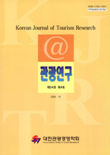- 영문명
- 일본인 한국관광수요의 결정요인 추정에 관한 연구
- 발행기관
- 대한관광경영학회
- 저자명
- Kim Heung-Sik(김흥식)
- 간행물 정보
- 『관광연구』제24권 제4호, 237~254쪽, 전체 18쪽
- 주제분류
- 사회과학 > 관광학
- 파일형태
- 발행일자
- 2009.10.30

국문 초록
본 연구에서는 여러 계량경제 수요모형 중에서 general to specific approach가 의해 한국에서의 일본인 관광객 수요매개변수를 측정하고 분석할 수 있는 가장 적절하고 실제적인 모형인 것으로 분석되었다. 즉, 주요 통계치는 유사한, 본 모형이 기타 Partial adjustment mode보다 표준오차가 더 작았고, NT test와 mis-specification test 관점에서 더 우수한 결과를 도출하였다. 또한, AIC와 SBIC를 기초로 한 model selection criteria의 결과도 non-nested test 결과와 일치하는 것으로 나타나 모형이 더 선호되는 것으로 나타났다. 추정된 일본인 관광객수의 교통비 및 소득탄력성은 경제이론에 부합하고 이전의 연구결과와 일치하는 것으로 나타났다. 소득변수가 1보다 커 수요에 탄력적이면서 수용에 가장 큰 영향을 미치는 것으로 나타났다. 환율요소를 고려한 관광가격탄력성은 물가요소에 의한 음(-)의 영향보다 환율요소에 의한 양(+)의 영향이 더 커서 1보다 큰 양(+)의 탄력치를 나타내, 일본인은 한국을 동남아시아 국가보다는 업그레이드된 관광목적지로 인식하고 있는 것으로 추정되었다. 또한, 추정된 장기 교통비 탄력성이 단기탄력성보다 더 작은 영향을 미치는 것으로 파악되었다. 교통비 이외의 변수들(소득, 관광가격지수 등)의 ADF 2차 차분이 non-stationary 했지만, 표본수의 제약과 degree of freedom과 추정치의 신뢰성을 저하시키지 않기 위해 DF tests의 2차 차분에 의존하여 general to specific 모형에 의해 수용의 결정인자를 추정하였다.
영문 초록
Among econometric models of tourism demand, this study utilizes that a single equation multivariate time series model in the form of double-log linear model to explain and forecast tourist arrivals to Korea from Japan. As the most relevant and practical model in estimating a parameter of Japanese tourists to Korea, we develop our multiple regression model by using a diluted version of the general to specific approach due to a small sample size. To select our optimal model, we first conduct a variable deletion test, and then the standard non-nested hypothesis tests. Finally, our alternative dynamic specification is subjected to both the Dickey-Fuller and Augmented Dickey-Fuller(ADF) tests. The model is used to quantify to changes in relative tourism prices, real income, relative transport costs, and external events. The results indicate that as estimated income, transport costs and price elasticities of Japanese tourists are consistent with the economic theory and comparable to previous empirical studies for other countries. The model offers valuable insights into the stylized facts of tourism behaviour and provides reliable out-of-sample forecasts.
목차
Abstract
Ⅰ. Introduction
Ⅱ. The Variable Specification and The Data
Ⅲ. Model Estimation and Empirical Results
Ⅳ. Summary and Concluding Remarks
References
요약
해당간행물 수록 논문
참고문헌
최근 이용한 논문
교보eBook 첫 방문을 환영 합니다!

신규가입 혜택 지급이 완료 되었습니다.
바로 사용 가능한 교보e캐시 1,000원 (유효기간 7일)
지금 바로 교보eBook의 다양한 콘텐츠를 이용해 보세요!


